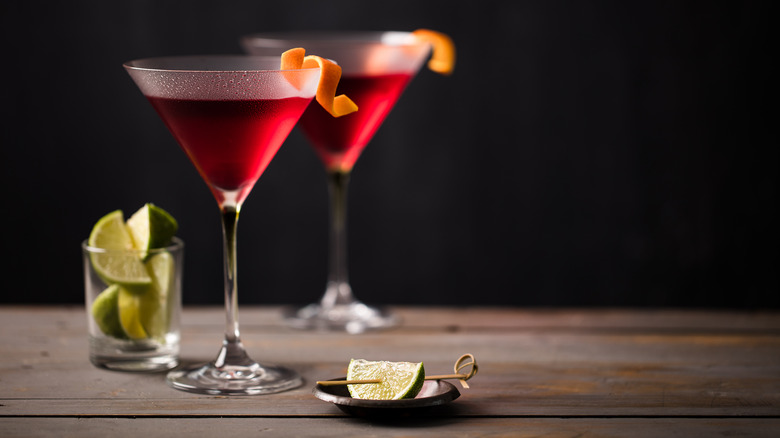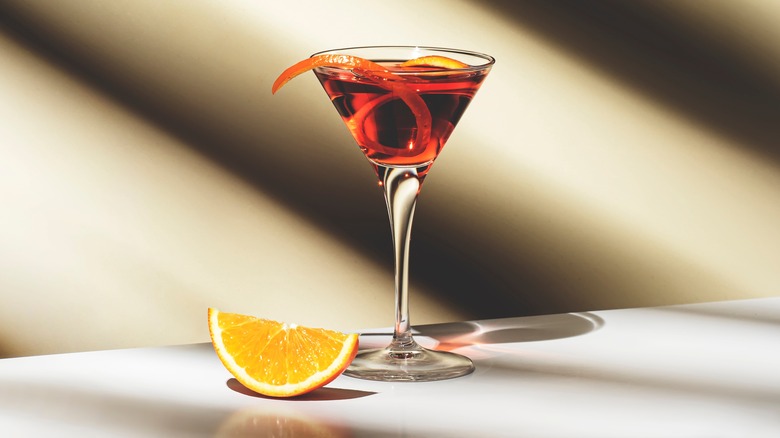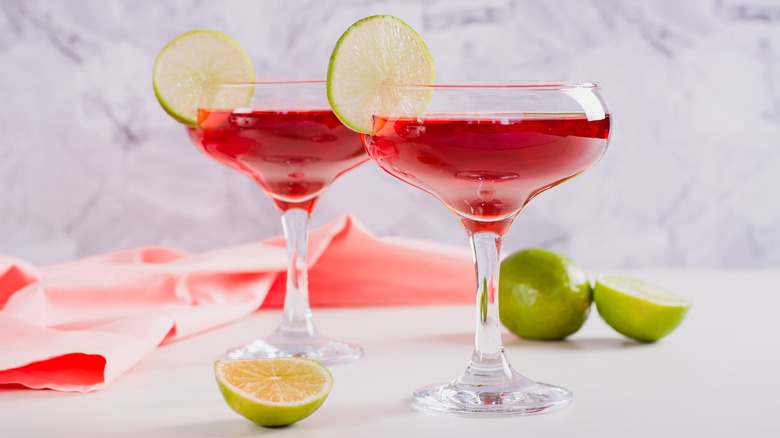How A French Cosmopolitan Differs From The Original Drink
You don't have to be a fan of "Sex and the City" to appreciate a cosmopolitan (although the HBO show undeniably popularized the drink). The framework varies slightly at times, but a standard and simple cosmopolitan recipe has an orange liqueur, vodka, and two kinds of fruit juice — freshly squeezed lime and sweetened cranberry juice. It works not only because of its eye-catching pink color, but also due to the sweet and tart combination buoyed by a dry base spirit.
The combination of liquids that create the Cosmo technically follow the formula for a sour (similar to a Margarita), which is a style of mixed drink that uses lemon or lime along with a base spirit, and a sweet element. The French Cosmopolitan is a variation of the original, with one big ingredient change — using Grand Marnier instead of Cointreau. Additionally, there is an added pop of color in the French Cosmopolitan thanks to a splash of grenadine.
How these ingredients change the drink
The beginner's guide to orange liqueurs covers the substantial differences between Grand Marnier and Cointreau. The former is a type of triple sec (a category of orange liqueurs made from orange peels that have been steeped in a neutral spirit), which is then combined with cognac that has been aged in oak barrels. The result is a spirit that is darker in color, with flavors that are a bit richer and nuttier.
Cointreau, on the other hand, is also a triple sec but is not aged or married with any additional spirits. Although both spirits function similarly, bringing the orange and an equal amount of alcohol (40% ABV) to the cocktail, these flavor differences do slightly alter the character of the resulting Cosmo, with the French version being a bit fuller bodied. Grand Marnier is also a little pricier, most likely because of the barrel-aged cognac.
The French Cosmo also has the addition of the flavored syrup known as grenadine. If you've ever wondered about the primary flavor you can taste in grenadine, it's pomegranate, which contributes a subtle tartness as well as that iconic red color — even in the minimal amount called for in this cocktail.
Cosmopolitan evolution
There are competing stories when it comes to the Cosmo's creation, and the word "French" actually appears as part of the oldest known recipe, in the form of vermouth. This century-old formula called for two kinds of whiskey, vodka, something called "Swedish punch," and two kinds of vermouth: Italian and French. While that version bears little resemblance to the cocktail we call the Cosmo today, one post-Prohibition iteration in the 1930s hews a bit closer to the contemporary recipe, except with gin, raspberry syrup, and lemon, but this is also where we start to see Cointreau.
There are stories about two very similar drinks that share the DNA of the modern Cosmo being created in the 1970s and '80s, in Minnesota and New York City, respectively, and some even point to San Francisco as well. No sources suggest that the drink has had real ties to France — aside from the fact that orange liqueurs are of French origin. Perhaps the idea that cognac is also involved (the spirit is a product of the Cognac region of France) plays a role in its naming.
Regardless of where the drink came from or how it wound up with this European flair, the French Cosmopolitan is a delicious cocktail despite (or, depending on how you look at it, because of) its differences to the classic. Fortunately, there's always room for another drink on the cocktail list.


